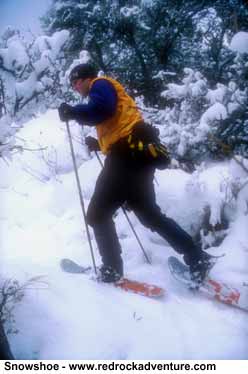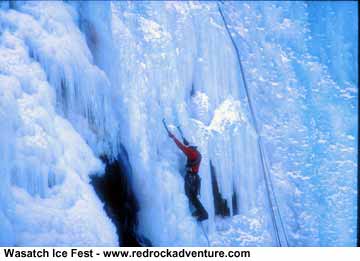
Young People Need Adventure
 By
Dave Webb
By
Dave Webb
I’m in a melancholy mood, writing this while listening to news reports about a powerful avalanche that buried an unknown number of skiers and snowboarders near The Canyons resort. Initial efforts failed to locate survivors. This morning the search shifted from rescue to recovery. It may be spring before all bodies are recovered and the full extent of this tragedy is known.
It’s sobering to realize my son or nephew could easily become such a victim. My heart goes out to the families and friends now wondering if their loved one is buried under the snow.
It’s doubly tragic because these people didn’t have to die. They made a conscious decision to disregard warning signs and ski or board in an area where avalanche danger was extreme.
This same scenario is repeated year after year, with death or debilitating injury coming to people skiing/boarding, canyoneering, rock climbing and participating in other adventure sports.
Today is one of those days when I reflect and ask, "Is it worth the risk?"
There is no easy answer to that question. Skiing out of bounds where there is extreme avalanche danger is certainly not worth the risk. But there are plenty of opportunities to participate in adventure sports that carry minimal risk. With proper training, proper equipment and common sense, almost every hazard can be avoided.
Yes, I did say "almost every." Adventure carries risk. On rare occasions accidents are unavoidable. So, again, I ask myself, "Is it worth the risk?"
 I
think it is. I believe adventurous activities, keep within reasonable
bounds, offer tremendous payoffs. And I’m talking about benefits
more tangible than the thrill that comes with the adrenalin rush. Sociological
studies, and my personal experiences, suggest adventurous activities help
kids develop confidence and self-esteem. Kids that fish and hike and ski
and camp are less likely to get into legal trouble. Participating with
family members can strengthen family bonds. The activities often become
serious hobbies that provide a lifetime of enjoyment.
I
think it is. I believe adventurous activities, keep within reasonable
bounds, offer tremendous payoffs. And I’m talking about benefits
more tangible than the thrill that comes with the adrenalin rush. Sociological
studies, and my personal experiences, suggest adventurous activities help
kids develop confidence and self-esteem. Kids that fish and hike and ski
and camp are less likely to get into legal trouble. Participating with
family members can strengthen family bonds. The activities often become
serious hobbies that provide a lifetime of enjoyment.
The trick is that part about keeping things within reasonable bounds. Male teenagers and young adults sometimes display an incomprehensible lack of common sense. Referring to the latest avalanche deaths, Summit County Sheriff Dave Edmunds said: "It's very frustrating because these kids should not have been in that area. This was an area that was roped off and signed, and they just chose to ignore it."
In fact, a warning sign displaying skull and crossbones, with the inscription "YOU CAN DIE," was posted in an attempt to keep skiers out of the dangerous area. The skiers ignored the sign, crossed the barricade... and died.
Many humans, myself included, seem to have an inborn craving for adventure. In order to survive, most of us learn to temper this appetite by using common sense. We discover we can have tremendous adventure rushes while minimizing risk.
Time and experience are required before some people learn that lesson. For example, my son got considerable attention from peers because he could usually do successful back-flips from a standing position on concrete sidewalks. Our pleading did nothing to curb this behavior. A wise doctor finally got through to him by saying one more concussion would probably cause permanent brain damage and he would end up wearing diapers the rest of his life. The diapers part sank in.
Kids are going to seek adventure. If not on the ski slopes then in cars drag racing down Main Street... or by experimenting with drugs... or who knows what. They will find ways their ways. I’d rather see them satisfy their adventure cravings on the ski slopes or the climbing walls.
Ways to minimize risk
There are ways parents can help minimize the risks kids face when participating in adventure sports. Here are some ideas:
- Participate with your children. They are more likely to use common sense when you are around.
- Start them early. Younger kids are often eager to learn. They are more likely to accept guidance, learn proper skills and accept safety rules. If they start later than their peers they may feel pressured to push beyond their skill levels trying to keep up.
- Enroll them in classes. If possible, give them the opportunity to learn from experts. Many accidents occur because self-taught adventurers don’t know or use correct techniques. Classes almost always include lessons on safety and ethics.
- Help them acquire appropriate gear. Have the right gear for the participant’s skill level, and for the circumstances. Good gear will make participation more comfortable and safe. Quality gear occasionally makes the difference between safety and injury.
- Insist on knowing where they are going, who they will be with, and details of their game plan.
Be aware of changing circumstances
Pay attention to the environment around you, for your own safety as you recreate and so you can discuss these matters with your children. Discuss weather and news reports.
Weather conditions during the past few months have been highly unusual in Utah and around the world. Nature’s furry has been apparent at times. Talk about these things in your home. Here are some starting points:
- Utah is having a warm, wet winter. The snowpack is well above normal throughout the state. Avalanche danger will remain high for some time. The Utah Avalanche Center website has great information to help people understand and avoid this danger: www.avalanche.org/~uac/
- With all that snow in the mountains, and with warmer than normal temperatures, runoff may be early and ferocious this year. Stream flooding may occur in many areas this spring. Many southern Utah canyons that have been dry the past few years will have flowing water this spring. With that water be a benefit, allowing you to backpack into areas that have been bone dry, or will it be a potential hazard?
- Ice conditions are unsafe on most of our reservoirs. This has been a bad year for ice fishing. But, March-like weather in January means there are already great opportunities for stream fishing, with pleasant conditions.
Adventure carries risk, no doubt about that. But families can enjoy adventurous activities with minimal risk if they develop proper skills, learn safety techniques, have proper equipment and use common sense. Wonderful rewards can come from such activities.
Copyright Dave Webb